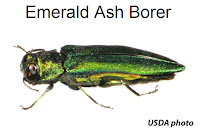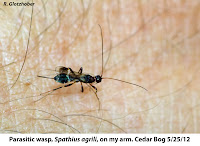Cookies in Collections
Ready to cook up a holiday tradition? Learn more about artifacts related to baking cookies in the collections of the Ohio History Connection.

The first wave of an invasion was observed in the Detroit area in 2002. Ash trees were dying everywhere in the region. The cause–a tiny metallic green beetle called the Emerald Ash Borer (abbreviated as EAB)–was likely introduced from Asia along with wooden shipping materials. By 2010, 20 million ash trees in southeastern Michigan, northern Ohio and Indiana were dead, with nearly 100% mortality. By that time, the infestation had spread to 13 states and two Canadian provinces, and the beetles continue to spread. Ash trees make up about 12 percent of all forest land in Ohio, and are particularly abundant in swamp forests. The devastation was so heavy that one of the Toledo Metro Parks with a lot of ash was closed for an extended time while workers came in to cut down and burn the trees in a combined effort to protect the public from falling trees and to attempt to halt the spread of more beetles.

At OHS we became concerned about the potential affect of EAB at Cedar Bog Nature Preserve in Champaign County. Cedar Bog is a complex of various wetland habitats surrounded by drier buffer areas. The most critical habitats are the sedge meadows and their surrounding evergreen swamp forests composed of Northern White Cedar. However, a large area of the preserve is a hardwood swamp forest, where Black Ash, Green Ash, White Ash and Pumpkin Ash abound. In the wettest areas of the swamp forest, ash trees are as much as 60 to 80 percent of all the trees. Several uncommon or rare species thrive in the swamp forest, including the state endangered Small Purple Fringed Orchid (Plantanthera psycodes). How do you protect ash trees from an exotic, invasive animal like the EAB? While there are chemical pesticides that are effective against the EAB, they are somewhat costly and impractical for anything beyond single, residential landscape trees. Further, the potential impact on other beetles and insects in a nature preserve quickly eliminated this type of approach at Cedar Bog.
As early as 2003, researchers with the USDA started looking for natural predators of the EAB back in Asia where the EAB is native. They found three species of tiny, non-stinging wasps that are parasitic on the eggs and larvae of EAB. Experiments showed that they parasitize no other insects beyond the EAB, or if really stressed some other borers in the same genus as the EAB. After extensive studies to confirm their safety, the USDA approved them for release to help control EAB infestations. The staff at OHS put together a proposal to introduce these parasitic wasps at Cedar Bog and submitted it to the Ohio Department of Natural Resources for approval a step required by Cedar Bogs status as a Dedicated State Nature Preserve. The ODNR fully endorsed our plan, and commended us for taking a pro-active step to protect this unique nature preserve.
After several years of monitoring the site, in October of 2011 the first adult EAB showed up in the purple pheromone traps at Cedar Bog. Only two each of the EABs in each of two traps. In past wasp introductions, this would not have been sufficient evidence to start introducing the wasps as the wasps are difficult and expensive to rear and the USDA wanted to make sure that releases took place at sites that had significant infestations of EAB. However, EAB may be established for a year or two already before they start showing signs of infestation, and many previous introductions were too little, too late. After several discussions, the staff at the USDA lab in Brighton, Michigan agreed that it was time to experiment with a more aggressive introduction of these parasitoid wasps. Yes!

On Friday, May 25, 2012 Dr. Avraham (Avi) Eitam of the USDA office in Reynoldsburg, Ohio brought out our first round of parasitoid wasps. Site manager Eric Doerzbacher and myself assisted him in locating the best spot for our introduction and then releasing the wasps. We selected a central point, and then divided the area around it into quadrants. Releases would take place on three ash trees in each of four adjacent quadrants to the central point. Since additional releases are planned, and monitoring of the effectiveness of the introduction is important, each tree used was marked with a numbered metal tag to assure our introductions and monitoring will be consistent.

A total of more than 4,000 parasitic wasps were released; 1877 of Spathius agrili (a parasite on larval EAB), 1088 Tetrastrichus planipennisi (another parasite on larvae) and 1452 Oobius agrili (a parasite on EAB eggs). Some people have expressed concern over the introduction of wasps might they not attack and sting visitors? The answer to that is a resounding NO. These wasps are very, very tiny the largest (Spathius) measuring only about 5 mm long (about 3/16 inch). The wasps were shipped by over-night delivery from Brighton, Michigan where they are reared to Dr. Eitams lab in Reynoldsburg inside of coolers. Friday, when Avi arrived with the coolers of wasps at Cedar Bog, we unpacked the small plastic containers which held the wasps and proceeded to open each up on the specified trees. The two species of larval parasitic wasps were shipped as adults so as we started releasing them, they flew and crawled not only on the ash trees, but also on our arms. It was sort of interesting, trying to ignore a few mosquitoes landing on us, so as not inadvertently swat one of these valuable wasps!

The egg-parasitic wasps (Oobius agrili) were shipped in the same plastic containers, but on eggs of EAB which they had already parasitized, and in which the wasp larvae were waiting to hatch and emerge. Instead of opening a container and letting the wasps fly away, these containers were tacked onto the trees upside down, with a layer of fine cloth netting sealing off the bottom. When the wasps emerge, they can easily crawl through the netting, and search the ash trees for more EAB eggs to parasitize. There is no guarantee that the introduction of these three species of parasitic wasps will eliminate or even control the Emerald Ash Borers. That is certainly the hope at least that they minimize the destruction of the ash trees and develop a balanced population of EAB and the parasites.
That type of balance exists in many native wood boring insects and their parasites or predators. That is also the type of balance that exists now with other examples of biological control of pests, such as the weevil that feeds upon Purple Loosestrife which a couple of decades ago had taken over much of our Lake Erie marshes. Today, Purple Loosestrife has been greatly reduced by the weevils and is no longer a major threat to the marshes.
So if this introduction of parasitoid wasps works, we might loose some ash trees, we will see some EAB surviving, but the parasitic wasps will keep the EAB from becoming so numerous that they wipe out all of our ash trees. All I can say is “Go wasps!”
Bob Glotzhober
Senior Curator of Natural History